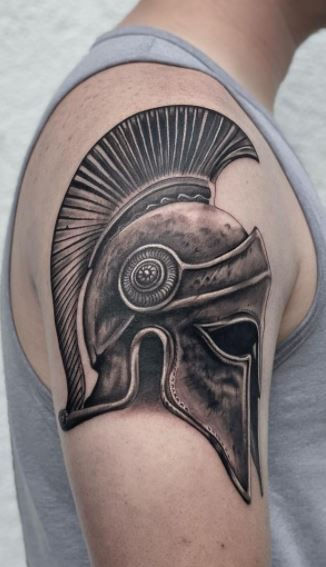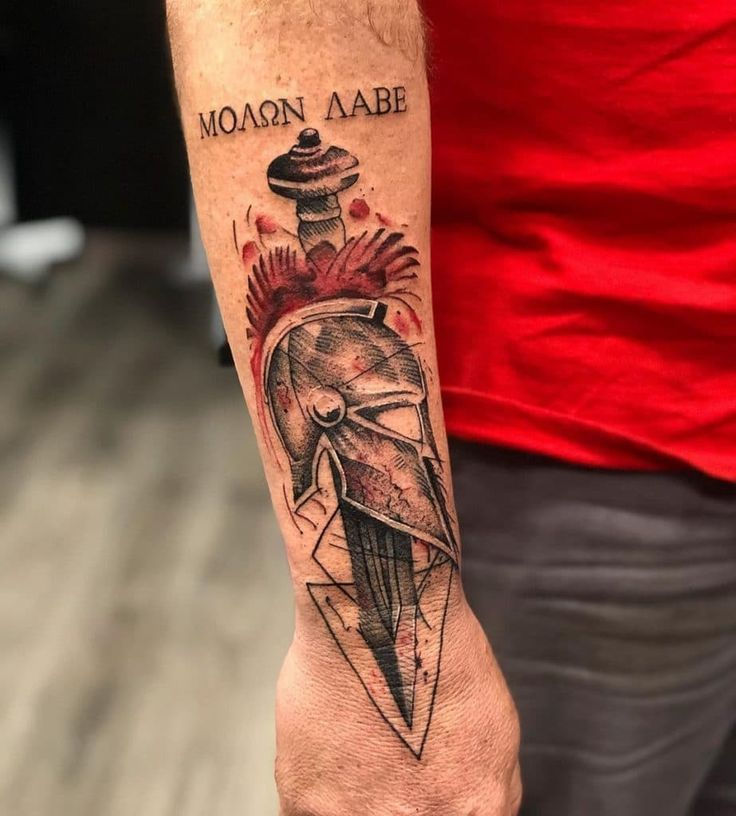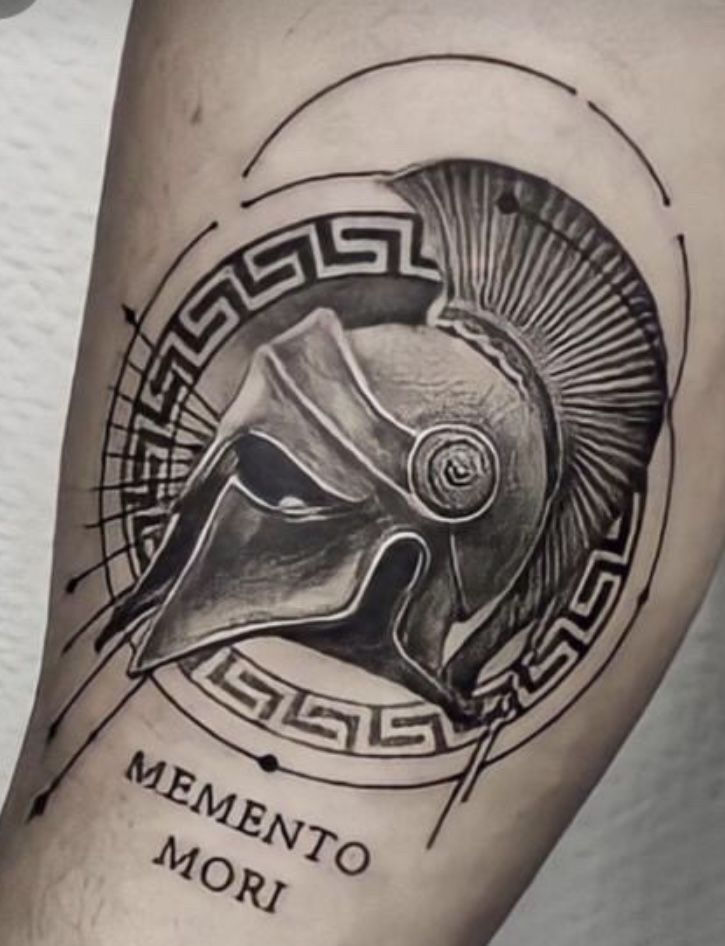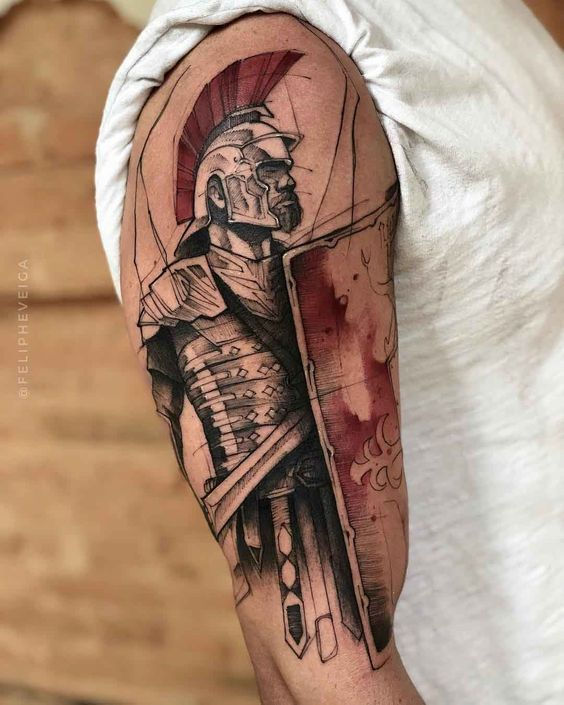Spartan Tattoos: History, Designs, and Aftercare
Spartan tattoos are a popular choice for those who admire the ancient warriors of Sparta, known for their discipline, strength, and unwavering courage. These tattoos are not just a form of body art; they are a powerful symbol of resilience, honor, and the warrior spirit.
The Spartans, who were renowned for their military prowess and strict societal structure, have become an enduring symbol of bravery and determination.
A Spartan tattoo can serve as a constant reminder of these values, inspiring the wearer to embody the same qualities in their own life.
The appeal of Spartan tattoos lies in their rich historical significance and the deep meaning they carry. These tattoos often feature iconic symbols such as the Spartan helmet, the lambda symbol, and imagery from the Battle of Thermopylae.
Each element of a Spartan tattoo is carefully chosen to reflect the values and virtues of the ancient warriors. Whether it's a detailed depiction of a Spartan warrior or a minimalist design, a Spartan tattoo can be a powerful statement of strength and resilience.

Choosing a Spartan tattoo involves more than just selecting a design; it requires a deep understanding of the symbolism and history behind the imagery. The design possibilities are vast, ranging from realistic portraits of Spartan warriors to abstract representations of their iconic symbols.
Each design can be customized to reflect the individual's personal interpretation of what it means to be a Spartan. The placement of the tattoo also plays a crucial role in its impact and visibility, with popular locations including the upper arm, chest, and back.
Proper aftercare is essential for ensuring that a Spartan tattoo heals correctly and maintains its vibrancy over time.
Following the tattoo artist's instructions and taking steps to protect the tattooed area can prevent complications and ensure the best possible outcome.
From keeping the area clean and dry to avoiding direct sunlight and swimming, each aspect of aftercare contributes to the long-term appearance and health of the tattoo.
By understanding the importance of aftercare and being diligent in following the recommended guidelines, individuals can enjoy their Spartan tattoos as lasting symbols of their inner strength and warrior spirit.
The History and Symbolism of Spartan Tattoos

Spartan tattoos are deeply rooted in the rich history and culture of ancient Sparta, a city-state in Greece known for its military prowess and disciplined society. The Spartans were renowned for their rigorous training, unwavering loyalty, and fierce combat skills.
A Spartan tattoo often incorporates symbols and imagery that reflect these qualities, serving as a tribute to the legendary warriors.
One of the most iconic symbols in Spartan tattoos is the Spartan helmet. This helmet, with its distinctive crest and design, represents the strength, bravery, and resilience of the Spartan warriors.
It is a powerful symbol of protection and readiness for battle, making it a popular choice for those who wish to embody the warrior spirit.
The helmet can be depicted in various styles, from highly detailed and realistic to more abstract and stylized designs.
Another significant symbol in Spartan tattoos is the lambda (Λ) symbol, which was emblazoned on the shields of Spartan warriors. The lambda represents the Lacedaemonians, the inhabitants of Sparta, and is a symbol of unity and strength.
Incorporating the lambda into a Spartan tattoo can signify a connection to the values of discipline, honor, and solidarity that defined Spartan society.

Imagery from the Battle of Thermopylae is also a common theme in Spartan tattoos. This historic battle, where a small force of Spartans led by King Leonidas held off a much larger Persian army, has become a symbol of courage and sacrifice.
A Spartan tattoo featuring scenes or elements from this battle can serve as a powerful reminder of the importance of standing firm in the face of overwhelming odds.
The Spartan shield, or hoplon, is another important symbol in Spartan tattoos. The shield was a crucial part of the Spartan warrior's equipment, representing protection and the collective strength of the phalanx formation. A tattoo featuring the Spartan shield can symbolize the importance of defense, unity, and the warrior's duty to protect their comrades.
In addition to these symbols, Spartan tattoos often incorporate elements such as spears, swords, and armor, further emphasizing the martial nature of Spartan society. These elements can be combined in various ways to create a unique and personalized design that reflects the wearer's admiration for the Spartan warriors and their values.
The historical and symbolic significance of Spartan tattoos makes them a powerful choice for those who wish to express their inner strength and resilience. By understanding the meaning behind the symbols and imagery, individuals can create a tattoo that not only looks impressive but also carries deep personal significance.
Popular Designs and Styles of Spartan Tattoos

Spartan tattoos come in a wide variety of designs and styles, each offering a unique way to express admiration for the ancient warriors.
From realistic portraits to abstract representations, the possibilities are endless. Choosing the right design and style is crucial for creating a Spartan tattoo that resonates with the wearer and effectively conveys the desired message.
One popular design for Spartan tattoos is the realistic portrait of a Spartan warrior. These tattoos often feature detailed depictions of warriors in full armor, complete with helmets, shields, and weapons.
The level of detail in these tattoos can be astonishing, capturing the fierce determination and strength of the Spartan warriors. Realistic portraits are a great choice for those who want a highly detailed and lifelike representation of a Spartan.
Another popular design is the minimalist Spartan tattoo. These tattoos use simple lines and shapes to create a stylized representation of Spartan symbols, such as the helmet or the lambda. Minimalist designs are often smaller and less intricate than realistic portraits, making them a good choice for those who prefer a more subtle and understated tattoo.
Despite their simplicity, minimalist Spartan tattoos can still carry a powerful message of strength and resilience.
Geometric Spartan tattoos are another popular style. These tattoos use geometric shapes and patterns to create a unique and abstract representation of Spartan symbols.

For example, a geometric Spartan helmet might be composed of triangles and lines, creating a modern and artistic interpretation of the traditional symbol. Geometric designs can add a contemporary twist to the ancient imagery, making them a popular choice for those who want a more modern look.
Blackwork Spartan tattoos are characterized by their use of solid black ink to create bold and striking designs. These tattoos often feature strong contrasts and heavy shading, resulting in a dramatic and eye-catching appearance.
Blackwork is a versatile style that can be used for both realistic and abstract designs, making it a popular choice for Spartan tattoos. The boldness of blackwork can effectively convey the strength and power of the Spartan warriors.
Watercolor Spartan tattoos are a more artistic and colorful option. These tattoos use vibrant colors and fluid brushstrokes to create a dynamic and visually stunning design. A watercolor Spartan tattoo might feature a helmet or warrior with splashes of red and blue, creating a sense of movement and energy. This style is perfect for those who want a more artistic and expressive tattoo that stands out.
Traditional Spartan tattoos draw inspiration from classic tattoo styles, such as American traditional or Japanese traditional. These tattoos often feature bold lines, vibrant colors, and iconic imagery. A traditional Spartan tattoo might incorporate elements such as roses, banners, or scrolls, adding a classic tattoo aesthetic to the Spartan symbols. This style is ideal for those who appreciate the timeless appeal of traditional tattoo art.
Finally, illustrative Spartan tattoos combine elements of realism and illustration to create a detailed and artistic design. These tattoos often feature intricate line work and shading, resulting in a highly detailed and visually impressive tattoo.
An illustrative Spartan tattoo might depict a warrior in battle, complete with detailed armor and weaponry. This style is perfect for those who want a highly detailed and artistic representation of the Spartan warriors.
Choosing the Right Placement for Your Spartan Tattoo

The placement of a Spartan tattoo is just as important as the design itself. The location of the tattoo can affect its visibility, impact, and overall aesthetic. Choosing the right placement involves considering factors such as the size of the tattoo, the design, and the individual's personal preferences. Here are some popular placement options for Spartan tattoos and the considerations for each.
The upper arm is a popular placement for Spartan tattoos, particularly for larger and more detailed designs. This area provides a relatively large canvas, allowing for intricate and detailed tattoos.
A Spartan helmet or warrior portrait can look impressive on the upper arm, and the natural contours of the arm can enhance the overall appearance of the tattoo. Additionally, the upper arm is easy to cover or reveal, making it a versatile placement option.
The chest is another popular placement for Spartan tattoos. This area is ideal for larger designs that require a broad canvas. A Spartan warrior or battle scene can look striking on the chest, and the central location can create a powerful and impactful tattoo.
The chest also allows for a more personal and intimate tattoo, as it can be easily covered with clothing. However, chest tattoos can be more painful due to the proximity to the bone, so it's important to consider pain tolerance when choosing this placement.
The back is a great option for those who want a large and detailed Spartan tattoo. The back provides a vast canvas, allowing for complex and expansive designs. A full-back tattoo can incorporate multiple elements, such as a Spartan warrior, helmet, and shield, creating a comprehensive and impressive piece of art.
The back is also a relatively low-pain area for tattooing, making it a popular choice for larger tattoos. However, back tattoos can be more challenging to care for during the healing process, so it's important to follow aftercare instructions carefully.

The forearm is a versatile placement option for Spartan tattoos. This area is suitable for both small and medium-sized designs, and the natural shape of the forearm can enhance the appearance of the tattoo.
A Spartan helmet or lambda symbol can look striking on the forearm, and the visibility of this area allows for a bold and impactful tattoo. The forearm is also a relatively low-pain area for tattooing, making it a popular choice for many individuals.
The calf is another popular placement for Spartan tattoos. This area provides a relatively large canvas, allowing for detailed and intricate designs. A Spartan warrior or battle scene can look impressive on the calf, and the natural contours of the leg can enhance the overall appearance of the tattoo.
The calf is also a relatively low-pain area for tattooing, making it a comfortable option for many individuals. Additionally, calf tattoos can be easily covered with clothing, providing versatility in visibility.
The shoulder is a great option for Spartan tattoos, particularly for medium-sized designs. This area provides a relatively large canvas, allowing for detailed and intricate tattoos. A Spartan helmet or warrior portrait can look impressive on the shoulder, and the natural contours of the shoulder can enhance the overall appearance of the tattoo.
The shoulder is also a relatively low-pain area for tattooing, making it a comfortable option for many individuals. Additionally, shoulder tattoos can be easily covered or revealed, providing versatility in visibility.
The thigh is a popular placement for larger Spartan tattoos. This area provides a broad canvas, allowing for complex and expansive designs. A Spartan warrior or battle scene can look striking on the thigh, and the central location can create a powerful and impactful tattoo. The thigh is also a relatively low-pain area for tattooing, making it a comfortable option for many individuals.
Additionally, thigh tattoos can be easily covered with clothing, providing versatility in visibility.
Finally, the ribcage is a unique and bold placement option for Spartan tattoos.
This area is ideal for larger and more detailed designs, and the natural shape of the ribcage can enhance the overall appearance of the tattoo. A Spartan warrior or battle scene can look striking on the ribcage, creating a powerful and impactful tattoo. However, ribcage tattoos can be more painful due to the proximity to the bone, so it's important to consider pain tolerance when choosing this placement.
The Process of Getting a Spartan Tattoo

Getting a Spartan tattoo involves several steps, from choosing the design and artist to the actual tattooing process and aftercare. Understanding each step can help ensure a smooth and successful experience. Here is a detailed overview of the process of getting a Spartan tattoo.
The first step in getting a Spartan tattoo is choosing the design. This involves researching different Spartan symbols and imagery, such as the Spartan helmet, lambda symbol, and warrior portraits. It's important to choose a design that resonates with you and reflects the qualities you admire in the Spartan warriors. Consider factors such as the size, style, and placement of the tattoo when selecting the design.
Once you have chosen a design, the next step is finding a skilled and experienced tattoo artist. Look for an artist who specializes in the style of tattoo you want, whether it's realistic, minimalist, geometric, or another style. Check their portfolio to see examples of their work and read reviews from previous clients. It's important to choose an artist who has a good reputation and a clean, professional studio.
After selecting an artist, schedule a consultation to discuss your design and placement. During the consultation, the artist will review your design ideas and provide feedback on how to achieve the best results. They may suggest adjustments to the design or placement to ensure the tattoo looks its best. This is also a good time to ask any questions you have about the process, including the expected duration and cost of the tattoo.

On the day of your tattoo appointment, make sure you are well-prepared. Get a good night's sleep, eat a healthy meal, and stay hydrated. Wear comfortable clothing that allows easy access to the area where the tattoo will be placed. Bring any reference images or design ideas you have to the appointment.
The tattooing process begins with the artist preparing the area to be tattooed. This involves cleaning and shaving the skin to ensure a smooth surface. The artist will then apply a stencil of the design to your skin, allowing you to see how the tattoo will look and make any final adjustments.
Once the stencil is in place, the artist will begin the tattooing process. This involves using a tattoo machine to inject ink into the skin, creating the design. The process can take several hours, depending on the size and complexity of the tattoo. It's important to stay relaxed and follow the artist's instructions during the process. If you need a break, let the artist know.
After the tattoo is complete, the artist will clean the area and apply a bandage to protect the tattoo. They will provide you with aftercare instructions, which are crucial for ensuring the tattoo heals properly. Follow these instructions carefully, including keeping the area clean and dry, avoiding direct sunlight, and applying any recommended ointments or creams.
The healing process for a Spartan tattoo can take several weeks. During this time, it's important to avoid activities that could irritate the tattoo, such as swimming, heavy exercise, and wearing tight clothing. Keep the tattoo moisturized and avoid picking at any scabs or peeling skin.
Once the tattoo has healed, you may need to schedule a follow-up appointment for any touch-ups or adjustments. This is a normal part of the process and ensures that your tattoo looks its best. Regular touch-ups can help maintain the appearance and vibrancy of your Spartan tattoo over time.
Aftercare and Maintenance for Spartan Tattoos

Proper aftercare is essential for ensuring that a Spartan tattoo heals correctly and maintains its vibrancy over time. Following the tattoo artist's instructions and taking steps to protect the tattooed area can prevent complications and ensure the best possible outcome. Here are some detailed aftercare and maintenance tips for Spartan tattoos.
Immediately after getting your Spartan tattoo, the artist will clean the area and apply a bandage to protect the tattoo. It's important to leave the bandage on for the recommended amount of time, usually a few hours, to allow the tattoo to begin healing. Avoid touching the tattoo with dirty hands to prevent infection.
Once you remove the bandage, gently wash the tattoo with lukewarm water and mild, fragrance-free soap. Use your hands to clean the area, avoiding any abrasive materials such as washcloths or sponges. Pat the tattoo dry with a clean, soft towel, being careful not to rub or irritate the skin.
After cleaning the tattoo, apply a thin layer of the recommended ointment or cream. This helps keep the tattoo moisturized and prevents it from drying out. Avoid using products that contain alcohol or fragrances, as these can irritate the skin and hinder the healing process. Follow the artist's instructions on how often to apply the ointment.
During the healing process, it's important to avoid exposing the tattoo to direct sunlight. UV rays can cause the tattoo to fade and increase the risk of sunburn. If you need to be outside, cover the tattoo with clothing or use a broad-spectrum sunscreen with a high SPF once the tattoo is fully healed.

Avoid swimming in pools, hot tubs, lakes, or the ocean until the tattoo is fully healed. Submerging the tattoo in water can introduce bacteria and increase the risk of infection. Additionally, the chemicals in pools and hot tubs can irritate the tattoo and hinder the healing process.
Refrain from heavy exercise and activities that cause excessive sweating during the initial healing period. Sweat can irritate the tattoo and increase the risk of infection. Light exercise and activities that do not strain the tattooed area can be resumed as the tattoo begins to heal.
It's normal for the tattoo to scab and peel during the healing process. Avoid picking at any scabs or peeling skin, as this can cause the tattoo to lose ink and result in uneven healing. Allow the scabs to fall off naturally, and continue to keep the area moisturized.
Once the tattoo is fully healed, it's important to continue taking care of it to maintain its appearance. Keep the tattoo moisturized with a fragrance-free lotion to prevent the skin from drying out. Regularly applying sunscreen to the tattooed area can help protect it from UV rays and prevent fading.
If you notice any signs of infection, such as excessive redness, swelling, pus, or a foul odor, contact your tattoo artist or a healthcare provider immediately. Early intervention can prevent more serious complications and ensure the tattoo heals properly.
Regular touch-ups may be necessary to maintain the appearance and vibrancy of your Spartan tattoo. Over time, tattoos can fade due to factors such as sun exposure and skin aging. Scheduling touch-up appointments with your tattoo artist can help keep your tattoo looking fresh and vibrant.






















































































Conclusion
Spartan tattoos are a powerful way to symbolize strength, resilience, and the warrior spirit. Whether you choose a realistic portrait of a Spartan warrior or a minimalist representation of the Spartan helmet, the key is to select a design that resonates with you and reflects the values you admire.
By understanding the history and symbolism behind Spartan tattoos, you can create a meaningful and impactful piece of art that serves as a constant reminder of your inner strength and determination.
The process of getting a Spartan tattoo involves careful planning and consideration. From choosing the right design and artist to ensuring proper aftercare, each step is crucial in achieving a tattoo that not only looks impressive but also holds significant meaning.
By working with a skilled and experienced tattoo artist, you can bring your vision to life and create a tattoo that truly embodies the qualities of the Spartan warriors.
Proper aftercare and maintenance are essential for ensuring that your Spartan tattoo heals correctly and maintains its vibrancy over time. Following the tattoo artist's instructions and taking steps to protect the tattooed area can prevent complications and ensure the best possible outcome.
By understanding the importance of aftercare and being diligent in following the recommended guidelines, you can enjoy your Spartan tattoo as a lasting symbol of your inner strength and warrior spirit.
In the end, a Spartan tattoo is more than just a piece of body art; it is a statement of who you are and what you stand for. It is a symbol of your
See More: ⤵
Shark Tattoo: A Guide to the Fierce and Fascinating World of Shark Ink
The Ultimate Guide to Black Hair and Tattoos: Embracing Your Unique Style
The Ultimate Guide to Beard Micropigmentation: Can You Do Micropigmentation on Beard?
Beard and Tattoo: A Comprehensive Guide to Combining Two Iconic Styles
Small Tattoos for Women: Delicate and Meaningful Design Ideas
Aztec Tattoos: Uncovering the Meaning and Symbolism Behind These Ancient Designs
Compass Tattoo: Meanings, Designs, and Ideas for Your Next Ink Adventure
Samurai Tattoo: Unleashing the Power of Japanese Warrior Art
Tree of Life Tattoo: Embracing the Timeless Symbol of Growth and Unity































Comments